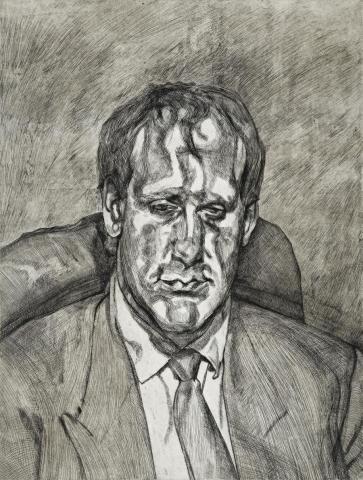HEAD OF AN IRISHMAN, 1999
LUCIAN FREUD
etching
74.0 x 56.0 cm
signed with initials and numbered below image
proofed and printed by Mark Balakjian and David Dawson at Studio Prints, London
Matthew Marks Gallery, New York
Rex Irwin Art Dealer, Sydney
Private collection, Sydney, since 1999
Hartley, C., The Etchings of Lucian Freud: A Catalogue raissoné 1946 - 1995 (Supplement), Marlborough Graphics and Ceribelli, London, 1995, cat. 60 (illus.)
Two Irishmen in WII 1984-85, oil on canvas, 172.8 x 141.7cm, collection of the artist
The grandson of eminent psychoanalyst Sigmund Freud, Lucian Freud is widely regarded as the most important figure in contemporary British painting. From his early works such as the celebrated Interior in Paddington, 1951, (Walker Art Gallery, Liverpool), he rendered his subjects with a meticulous intensity, already displaying the harsh and penetrating observation that would inspire Kenneth Clark's famous description of him as the 'Ingres of Existentialism.' During the late fifties however, he substituted sable for hogshair brushes, and accordingly, this miniaturist style gave way to a broader, more robust approach; as Freud himself elucidates, '...I would wish my portraits to be of the people, not like them. Not having the look of the sitter, being them. As far as I am concerned, the paint is the person, I want it to work for me just as flesh does.'1
Today this voracious attitude to his subject is considered the defining feature of his Freud's art. Stripping his subjects bare psychologically (and usually literally as well), he focuses upon the nakedness and vulnerability of human flesh, exposing its blotches, veins and wrinkles to a pitiless, devouring gaze. Dramas without incident or narrative, his portraits are distinctly disturbing in their carnality, thereby encapsulating Freud's belief that '...the task of the artist is to make the human being uncomfortable.'2 As reiterated by Robert Hughes in his highly acclaimed monograph on the artist, the reality pursued in Freud's paintings goes far beyond naturalism: it is both startling and disconcerting, producing some of the most powerful and harrowing images of the twentieth century.3
Executed with the painstaking scrutiny that Freud brings to all his subjects, the present Head of an Irishman nevertheless betrays a certain warmth or empathy, poignantly expressed through the pensive, even despondent gaze of the sitter. Interestingly, the artist had previously portrayed this figure accompanied by his father in Two Irishman in WII, 1984-85, - the seated father, a keen collector of Freud's art, seemingly delighted to be painted again while the son standing behind, does not quite share his enthusiasm. Underlying both portraits however, is a powerful sense that neither feels at ease in London - the father's hands could easily tear open the upholstery of the armrests, while the son hesitantly grips the chair back. Fifteen years later, it is ironically the son who now assumes the seated position, nostalgic perhaps in his contemplation of his father and the earlier portrait sitting. An outstanding example of the intimate portraits of family and friends for which he is best renowned, indeed the etching may also be appreciated as a portrait of the artist himself, reflecting echoes and nuances of his own world; as Freud acknowledges 'Painters who use life will eventually reveal a facet of their lives... My work is purely autobiographical.'4
1. Freud cited in Lampert, C., Lucian Freud: Recent Work, Whitechapel Art Gallery, London, 1993, p.6
2. Freud cited at http://richardnagy.com/artists/lucienfreud/
3. Hughes, R., Lucian Freud: Paintings, Thames and Hudson, London, 1997.
4. Freud cited in an interview in Art Review, 2002: see http://www.constable.net
VERONICA ANGELATOS
